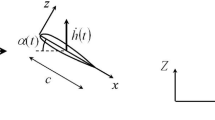Abstract
This contribution presents experimental results of a two-element high-lift airfoil in a disturbed inflow. Permanent disturbances are generated by the wakes of two static airfoils located upstream of the research airfoil, one of which is a planar wake by an infinite airfoil and the other is a longitudinal vortex emanating from a finite wing. The disturbances induce spanwise gradients into the flow. The disturbed flow field is measured by Particle Image Velocimetry. The interaction of the disturbed flow field with the high-lift airfoil is investigated by means of static surface pressure close to the airfoil’s leading- and trailing-edge, as well as surface hotfilm measurements and oil flow visualizations on the high-lift flap. For small and moderate incidences the airfoil is mainly influenced by the circulation induced by the disturbances, which affect the effective flow angles. Local effects that result from the turbulence in the airfoil-wake and the induced transverse velocity of the disturbances are likewise considered. At high angle of attack, the prevailing stall conditions with strong variations in spanwise direction are discussed.














Similar content being viewed by others
References
Hahn, D., Scholz, P., Semaan, R., Radespiel, R., Müller-Eigner, R.: Erzeugung definierter Querwirbel in einer geschlossenen Messstrecke,’ 60. Deutscher Luft- und Raumfahrtkongress, DGLR, Bremen (2011)
Klein, S., Hoppmann, D., Scholz, P., Radespiel, R.: High-lift airfoil interacting with a vortical disturbance: wind-tunnel measurements. AIAA J. 53(6), 1681–1692 (2015)
Klein, S., Scholz, P., Radespiel, R.: Interaction of three-dimensional disturbances with the flow around a two-element high-lift airfoil, 4th Symposium “Simulation of Wing and Nacelle Stall”. TU Braunschweig, Braunschweig (2014)
Ham, N.D.: Some conclusions from an investigation of blade–vortex interaction. J. Am. Helicopter Soc. 20, 26–31 (1975)
Patel, M.H., Hancock, G.J.: Some experimental results of the effect of a streamwise vortex on a two-dimensional wing. Aeronaut. J. 78(760), 151–155 (1974)
Bodstein, G.C.R., George, A.R., Hui, C.Y.: The three-dimensional interaction of a streamwise vortex with a large-chord lifting surface: theory and experiment. J. Fluid Mech. 322, 51–79 (1996)
McAlister, K.W., Tung, C.: Interaction between an airfoil and a streamwise vortex, 17th Fluid Dynamics, Plasma Dynamics, and Lasers Conference, AIAA-84-1626, Snowmass (1984)
Rockwell, D.: Vortex–body interaction. Annu. Rev. Fluid Mech. 30, 199–229 (1998)
Beck, N., Radespiel, R., Lenfers, C., Friedrichs, J., Rezaeian, A.: Aerodynamic effects of propeller slipstream on a wing with circulation control. J. Aircr. 52(5), 1422–1436 (2015)
Haines, A.B., Young, A.D.: Scale effects on aircraft and weapon aerodynamic. AGARDograph 323, 27–65 (1994)
Landa, T., Radespiel, R., Wild, J.: Numerical simulations of streamwise vortices on a generic high-lift configuration, 54th AIAA Aerospace Sciences Meeting, AIAA-2016-0304, San Diego (2016)
Helmke, C., Auerswald, T., Raasch, S., Bange, J.: Comparison of two methods to provide highly resolved atmospheric turbulence data for simulations of wing and nacelle circulations, 2nd Symposium “Simulation of Wing and Nacelle Stall’’. TU Braunschweig, Braunschweig (2010)
Wild, J.: Mach and Reynolds number dependencies of the stall behavior of high-lift wing-sections. J. Aircr. 50(4), 1202–1216 (2013)
Scholz, P., Kähler, C.J., Radespiel, R., Wild, J., Wichmann, G.: Active control of leading-edge separation within the German Flow Control Network, 47th AIAA Aerospace Science Meeting, AIAA-2009-529, Orlando (2009)
Hahn, D., Scholz, P., Radespiel, R.: Experimental evaluation of the stall characteristics of a two-element high lift airfoil, 2nd Symposium “Simulation of Wing and Nacelle Stall’’, SFB FOR 1066, Braunschweig (2010)
Simpson, R.L.: Turbulent boundary-layer separation. Annu. Rev. Fluid Mech. 21, 205–234 (1989)
Wawrzinek, K.P., Lutz, T., Krämer, E.: Numerical studies of turbulent flow influence on a two-element airfoil, 4th Symposium “Simulation of Wing and Nacelle Stall”. TU Braunschweig, Braunschweig (2014)
Reuß, S., Probst, A., Knopp, T., Wawrzinek, K.P.: Hybrid RANS/LES study of the development of an airfoil-generated vortex, 4th Symposium “Simulation of Wing and Nacelle Stall”. TU Braunschweig, Braunschweig (2014)
Radespiel, R., et al.: Simulation of wing and nacelle stall, 54th AIAA Aerospace Sciences Meeting, AIAA. 2016-1830, San Diego (2016)
Acknowledgements
The members of the FOR 1066 research group gratefully acknowledge the support of the “Deutsche Forschungsgemeinschaft DFG” (German Research Foundation) which funded this research.
Author information
Authors and Affiliations
Corresponding author
Additional information
This paper is based on a presentation at the German Aerospace Congress, September 22–24, 2015, Rostock, Germany.
Rights and permissions
About this article
Cite this article
Klein, S., Scholz, P. & Radespiel, R. A two-element high-lift airfoil in disturbed flow conditions. CEAS Aeronaut J 8, 79–91 (2017). https://doi.org/10.1007/s13272-016-0221-4
Received:
Revised:
Accepted:
Published:
Issue Date:
DOI: https://doi.org/10.1007/s13272-016-0221-4




